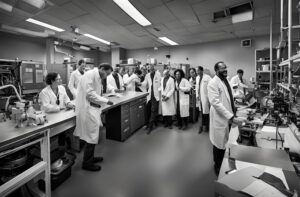
In an alternate reality, the United States found itself in an unprecedented financial position: zero debt and a substantial surplus. This remarkable turn of events began with a series of unexpected technological breakthroughs and a paradigm shift in governance.

It all started in the early 2020s when a group of scientists at a small, underfunded research lab in Silicon Valley made a groundbreaking discovery. They developed a new form of clean, renewable energy that was not only incredibly efficient but also inexpensive to produce. This energy source, dubbed “Quantum Fusion,” harnessed the power of quantum particles to generate limitless electricity without any harmful emissions. The implications were staggering.
The U.S. government quickly recognized the potential of Quantum Fusion and invested heavily in its development and deployment. Within a few years, Quantum Fusion plants replaced traditional coal, gas, and nuclear power stations across the country. The United States became the world’s leading exporter of clean energy technology, creating a massive influx of revenue.
With the newfound wealth, the government made a bold decision: to pay off the national debt entirely. This move was met with skepticism and resistance from some quarters, but the administration pressed on. By the mid-2030s, the U.S. had not only eliminated its debt but also accumulated a significant surplus.
The economic landscape of the country transformed dramatically. With no debt to service, the government had more resources to invest in infrastructure, education, and healthcare. Roads and bridges that had long been in disrepair were rebuilt, creating millions of jobs and stimulating the economy. Public schools received unprecedented funding, leading to a renaissance in American education. Healthcare became more accessible and affordable, with the government investing in cutting-edge medical research and facilities.
The surplus also allowed for substantial tax cuts, putting more money in the pockets of ordinary Americans. Consumer spending surged, driving economic growth to levels not seen in decades. Small businesses flourished, and entrepreneurship thrived as people had the financial security to take risks and innovate.

Internationally, the U.S. used its surplus to strengthen diplomatic ties and provide humanitarian aid. The country became a beacon of stability and prosperity in a world often fraught with conflict and economic hardship. The U.S. led global efforts to combat climate change, leveraging its Quantum Fusion technology to help other nations reduce their carbon footprints.
However, this newfound prosperity was not without its challenges. The rapid economic growth led to concerns about income inequality and the concentration of wealth. The government implemented policies to address these issues, such as progressive taxation and social welfare programs. These measures aimed to ensure that the benefits of the surplus were shared broadly across society.
As the decades passed, the U.S. continued to thrive. The surplus allowed for ambitious projects that had once seemed like science fiction. High-speed rail networks connected every major city, reducing the need for air travel and cutting down on carbon emissions. Space exploration received a significant boost, with manned missions to Mars and beyond becoming a reality. The U.S. became a leader in artificial intelligence and robotics, with these technologies integrated into everyday life to improve efficiency and quality of life.
The cultural landscape of the country also evolved. With more resources available for the arts and humanities, there was a renaissance in American culture. Music, literature, and the visual arts flourished, reflecting the diverse and dynamic society that the U.S. had become. Public spaces were revitalized, and cities became more livable and vibrant.
As the 21st century drew to a close, the United States stood as a testament to the power of innovation and prudent governance. The journey from a nation burdened by debt to one of unparalleled prosperity had not been easy, but it had been transformative. The lessons learned along the way shaped the country’s future, ensuring that the benefits of the surplus were used to build a more equitable and sustainable society.




